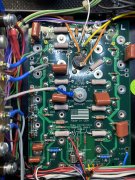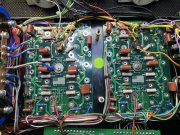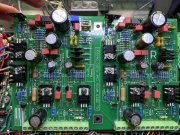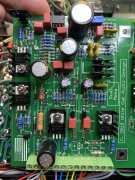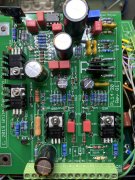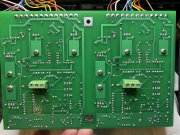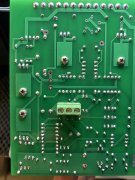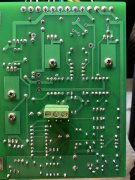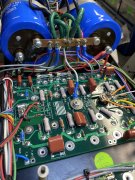dtafil
Journeyman
- Joined
- Jan 23, 2020
- Messages
- 101
Hey guys - Been a while. Still enjoying the heck out of my WOPL'ed 700b... so much so that I wanted 2, lol.
In any event, following the bring up routine for my new, full WOPL build, as follows:
1. Populated bottom row of transistors, floated star ground, bringup slowly on Variac w/ dim bulb. Passed, DC protection relays click. No blown fuses.
(Discharged bulk caps)
2. Same as #1, but connect single star ground. Bringup slowly on Variac w/ dim bulb. Passed, DC protection relays click. No blown fuses.
(Discharged bulk caps)
3. Added driver board, all connections. 500 mA fuse (F2) on Left backplane blows.
I did replace the fuse, hung a multimeter across F2, slowly bring up system w/ Variac & dim bulb. DC mV climbing across F2. Powered down before fuse popped. I did check all other voltages across other fuses, they remain at ~0.1 mV DC throughout.
Any suggestions on where to begin debug? No destroyed silpads this time
Will add some pics if there's an area of interest.
Thanks guys!
In any event, following the bring up routine for my new, full WOPL build, as follows:
1. Populated bottom row of transistors, floated star ground, bringup slowly on Variac w/ dim bulb. Passed, DC protection relays click. No blown fuses.
(Discharged bulk caps)
2. Same as #1, but connect single star ground. Bringup slowly on Variac w/ dim bulb. Passed, DC protection relays click. No blown fuses.
(Discharged bulk caps)
3. Added driver board, all connections. 500 mA fuse (F2) on Left backplane blows.
I did replace the fuse, hung a multimeter across F2, slowly bring up system w/ Variac & dim bulb. DC mV climbing across F2. Powered down before fuse popped. I did check all other voltages across other fuses, they remain at ~0.1 mV DC throughout.
Any suggestions on where to begin debug? No destroyed silpads this time
Will add some pics if there's an area of interest.
Thanks guys!
Last edited:

